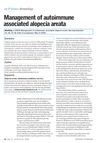Comparison of Alopecia areata in Human and Nonhuman Mammalian Species
January 1998
in “Pathobiology”
TLDR The document concludes that certain rats and mice are useful for studying hair loss in humans and testing treatments.
The document from 1998 discusses Alopecia areata (AA), a type of hair loss that affects both humans and other mammalian species. It highlights the use of the Dundee experimental bald rat and the C3H/HeJ mouse as animal models for studying human AA. The condition is characterized by a range of symptoms from small patches to almost complete hair loss and is marked by dystrophic anagen hair follicles and an inflammatory cell presence around and within hair follicles. Autoantibodies against hair follicle structures during the anagen phase are commonly observed across species. The paper suggests that these nonhuman models are valuable for understanding the genetic and environmental factors involved in AA, as well as for testing new treatments.
View this study on karger.com →
Related

research Individualized Homeopathic Approach in Alopecia Areata: An Evidence-Based Case Report
Homoeopathic treatment may help restore hair in Alopecia Areata by balancing the immune system.
research Alopecia areata: A multifactorial autoimmune condition
Alopecia areata is an autoimmune disease causing patchy hair loss, often with other autoimmune disorders, but its exact causes are unknown.
research Treating of resistant cases of alopecia universalis
Combining platelet-rich plasma therapy with prostaglandin-F eye drops can significantly regrow hair in alopecia universalis.

research Management of autoimmune associated alopecia areata
Treatments for autoimmune hair loss have limited success and often relapse, and emotional support is crucial for those affected.